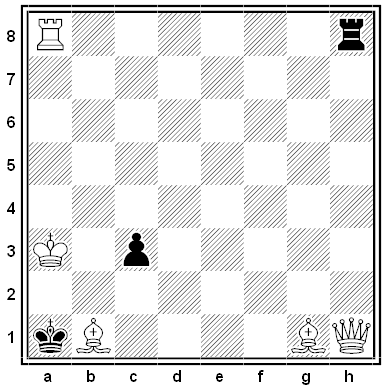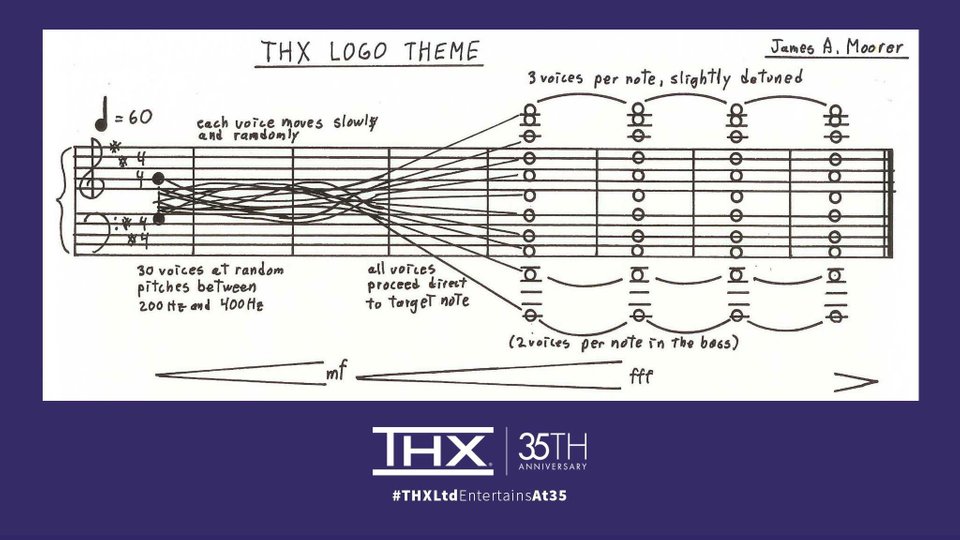
I just ran across this in Benjamin Glover Laws’ The Two-Move Chess Problem, from 1890. It’s by G. Chocholous. White is to mate in two moves.

I just ran across this in Benjamin Glover Laws’ The Two-Move Chess Problem, from 1890. It’s by G. Chocholous. White is to mate in two moves.
Discovered by State Farm research agents in 2001:
Antonio Parkway crosses Avenida de las Banderas in Rancho Santa Margarita, California.
Grinn Drive meets Barret Road in West Chester, Ohio.
East Ho Road meets North Hum Road in Carefree, Arizona.
Dock Street connects Hickory Avenue and Dickory Avenue in Harahan, Louisiana.

On its 35th anniversary, THX, the sound quality assurance company founded by George Lucas, released the original score of “Deep Note,” its audio trademark, which debuted at the premiere of Return of the Jedi in 1983 and is now familiar from countless films. Essentially it’s a stupendous D chord; the U.S. trademark registration reads:
The THX logo theme consists of 30 voices over seven measures, starting in a narrow range, 200 to 400 Hz, and slowly diverting to preselected pitches encompassing three octaves. The 30 voices begin at pitches between 200 Hz and 400 Hz and arrive at pre-selected pitches spanning three octaves by the fourth measure. The highest pitch is slightly detuned while there are double the number of voices of the lowest two pitches.
“I like to say that the THX sound is the most widely-recognized piece of computer-generated music in the world,” says James A. Moorer, who wrote it. “This may or may not be true, but it sounds cool.” And now that we have the score you can do this:
286 = 77371252455336267181195264
That’s the largest known power of 2 with no zeros in its decimal representation.
Are there higher such powers? No one knows.
any-lengthian
adj. unscrupulous
anythingarianism
n. the fact or phenomenon of not holding any fixed or established beliefs
Created by Franz Armbruster in 1967, “Instant Insanity” was the Rubik’s Cube of its day, a simple configuration task with a dismaying number of combinations. You’re given four cubes whose faces are colored red, blue, green, and yellow:

The task is to arrange them into a stack so that each of the four colors appears on each side of the stack. This is difficult to achieve by trial and error, as the cubes can be arranged in 41,472 ways, and only 8 of these give a valid solution.
One approach is to use graph theory — draw points of the four face colors and connect them to show which pairs of colors fall on opposite faces of each cube:

Then, using certain criteria (explained here), we can derive two directed subgraphs that describe the solution:

The first graph shows which colors appear on the front and back of each cube, the second which colors appear on the left and right. Each arrow represents one of the four cubes and the position of each of the two colors it indicates. So, for example, the black arrow at the top of the first graph indicates that the first cube will have yellow on the front face and blue on the rear.
This solution isn’t unique, of course — once you’ve compiled a winning stack you can rotate it or rearrange the order of the cubes without affecting its validity. B.L. Schwartz gives an alternative method, through inspection of a table, as well as tips for solving by trial and error using physical cubes, in “An Improved Solution to ‘Instant Insanity,'” Mathematics Magazine 43:1 (January 1970), 20-23.

“If you have an apple and I have an apple and we exchange apples then you and I will still each have one apple. But if you have an idea and I have an idea and we exchange these ideas, each of us will have two ideas.” — George Bernard Shaw
“He who receives an idea from me, receives instruction himself without lessening mine; as he who lights his taper at mine, receives light without darkening me. That ideas should freely spread from one to another over the globe, for the moral and mutual instruction of man, and improvement of his condition, seems to have been peculiarly and benevolently designed by nature, when she made them, like fire, expansible over all space, without lessening their density in any point.” — Thomas Jefferson

The end of the Civil War opened a new era of fossil hunting in the American West — and a bitter feud between two rival paleontologists, who spent 20 years sabotaging one another in a constant struggle for supremacy. In this week’s episode of the Futility Closet podcast we’ll tell the story of the Bone Wars, the greatest scientific feud of the 19th century.
We’ll also sympathize with Scunthorpe and puzzle over why a driver can’t drive.

I just ran across this, offered by Morton C. Schwartz in an old issue of Pi Mu Episilon Journal:
Take any number of zeros and any number of ones and place them in a circle, in any order. Reproduce the circle a second time, concentrically with the first. Rotate either circle, and any number of places. The number of zeros opposite ones will always be even.
(Morton C. Schwartz, “An Amazing Parity Theorem,” Pi Mu Episilon Journal 5:7 [Fall 1972], 338.)
https://www.youtube.com/watch?v=KcidhLw94_k
Cape Town artist Philip Barlow depicts “out-of-focus” cityscapes and beach scenes in oil paints. In photography this effect is known as bokeh, the blurring of elements that lie outside the depth of field. Others have said that Barlow renders the world as it might appear to a near-sighted person.
In this sense the subjects of his paintings are not the objects they depict but rather light itself. “The figures in the landscape serve as carriers and reflectors of the light that falls upon them. Bathed in the luminosity, it is my hope that they would become more beautiful. To me, light is the ultimate subject because it embodies the pinnacle of all reality.”